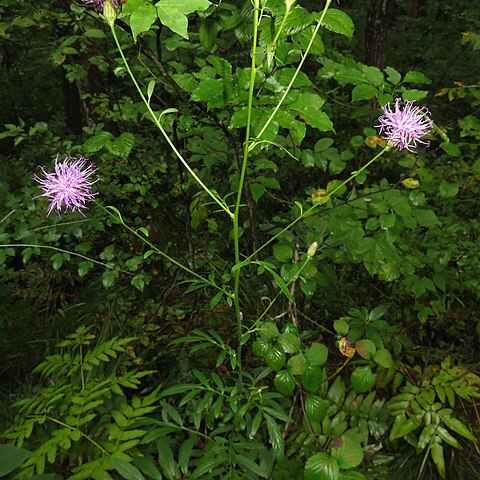Herbs 0.6-1.5 m tall. Rhizomes stout, procumbent. Stems erect, apically branched, rarely unbranched, glabrous. Basal and lower stem leaves petiolate, strigose to glabrescent; petiole 5-16 cm; leaf blade oblong to elliptic in outline, to 40 × 12 cm, pinnatisect or pinnate; segments narrowly elliptic, margin dentate or serrate; lateral segments 3-8 pairs, asymmetrical, decurrent on rachis. Middle and upper stem leaves sessile, similar in form and same in division as basal and lower stem leaves but smaller. Capitula heterogamous, few or rarely 1. Involucre bowl-shaped to campanulate, 1.2-2.5 cm in diam., with brownish lanate to velvety pubescence, rarely glabrescent. Phyllaries imbricate, in 6 or 7 rows, abaxially purplish red; outer phyllaries triangular to ovate, 3-7 × 1.5-4 mm, apex acute and with a spinule; middle and inner phyllaries elliptic, narrowly elliptic, or lanceolate, 10-18 × 3-4 mm, apex acuminate to acute; innermost phyllaries linear, ca. 20 × 1 mm. Corolla purple, 2-2.8 cm in female florets, ca. 2 cm in bisexual florets. Achene oblanceolate-ellipsoid, ca. 7 mm, many striate. Pappus elements yellowish brown, to ca. 1.2 cm, scabrid. Fl. and fr. Jul-Oct. 2n = 22.
More
A robust herb. It keeps growing from year to year. It grows 50-140 cm high. The branches appear at the uppermost leaf axil. There are leaves at the base and along the stem. The leaves are 40 cm long by 12 cm wide. They are divided into narrow segments along the stalk. There are 3-8 segments that are unequal in opposite sides. There are teeth along the edge.
Mountains of C. and S. Japan. Forests, forest margins on mountain slopes, steppes, meadows and river banks at elevations of 130-1600 metres in China.
More
It is a temperate plant. It grows on the edges of forests on mountain slopes between 100-1,600 m above sea level in north China.

